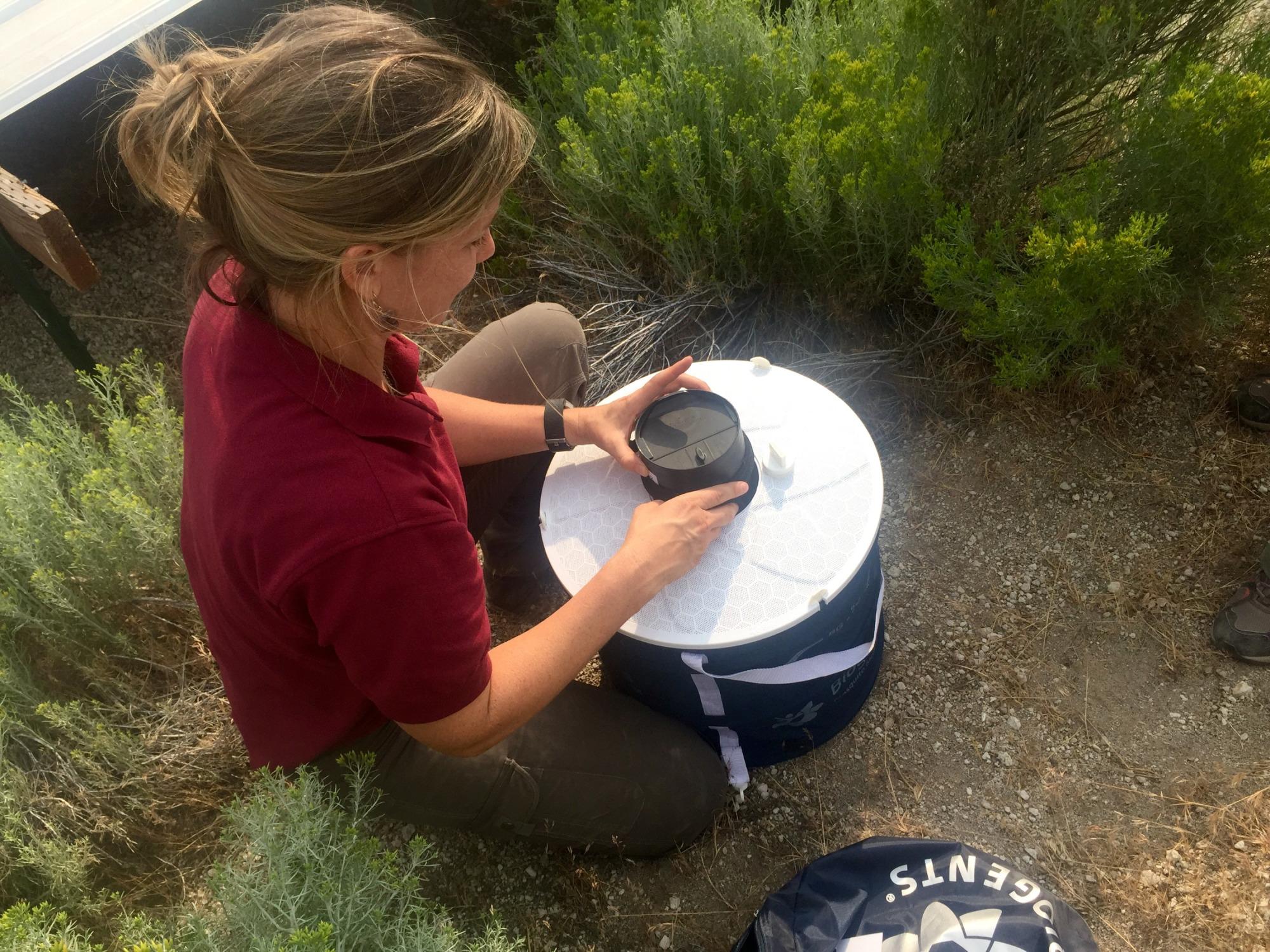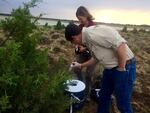
Emily Weidner, a biologist with the U.S. Fish and Wildlife Service, sets a trap to collect mosquitoes. She's helping study how many West Nile-carrying mosquitoes are in Oregon's sagebrush country.
Courtney Flatt
Deep in Oregon’s sagebrush country, the wind picks up. A storm turns the sky gunmetal gray.
But biologist Emily Weidner isn’t too worried about the possible rainfall. Or how it might hurt her chances of capturing an insect most of us try to avoid: mosquitoes.
“Mosquitoes don’t like winds higher than 5 to 10 miles-per-hour. This is a little bit more than that,” Weidner said as she set up a mosquito trap. “They don’t like heavy rain, but out here things don’t last that long.”
Each week during peak mosquito breeding season this summer, Weidner and a team of volunteers set stinky traps for the insects. They’re hoping to figure out just how many West Nile virus-carrying mosquitoes are flying around Central Oregon’s desert.
Turns out, the mosquito-transmitted virus is deadly for one of the West’s most iconic birds: the sage grouse.
The chicken-sized birds are known for goofy-looking dancing on their mating grounds — known as leks.

A male great western sage grouse.
U.S. Fish and Wildlife Service
“They look so serious while they’re lekking. All of the sudden you’ll see two males chasing after each other, hair on fire. It lends a little bit of comedic error to the whole situation,” said Weidner, a biologist with the U.S. Fish and Wildlife Service.
Sage grouse face a lot of threats in this wide-open country. Their numbers have fallen from historic levels of millions of birds to somewhere less than 500,000 across the West.
Their fate is tied up in public land-use debates. The small birds have brought together unlikely groups of ranchers, conservationists, biologists and politicians. They’re all working to avoid adding the birds to the endangered species list, which could spell out more potential land restrictions across 11 states, including Washington, Oregon and Idaho.
The birds’ habitat has been split up by wildfires, overgrazing, encroaching juniper trees, oil and gas drilling.
Related: Interior Department Overhauls Sage Grouse Recovery Plans
Lee Foster is the Sage-Grouse Conservation Coordinator with the Oregon Department of Fish and Wildlife. He’s studied sage grouse his entire career, even counting lekking grounds with his dad as a teenager.
“The landscape that they inhabit — it’s amazing that they can make a living out here, where we go from 105 degrees during the summer time to negative 20 in the winter, and persist in just an absolutely beautiful place,” he said.
One threat that people don’t know much about: the West Nile virus. Most sage grouse that become infected die relatively quickly, which means the virus could kill a lot of birds.
But the rates of infection? That’s unknown.
“It’s been detected in Oregon just about every year since it showed up,” Foster said. “However, most of those cases have either been in people, in horses, or in mosquitoes trapped near human occupation. And obviously sage grouse don’t live near people.”
That’s why these biologists have partnered with other federal agencies and conservation groups to figure out how many West Nile-carrying mosquitoes live in this vast landscape.
“We know that it’s a potential stressor for sage grouse population growth. But at this point we don’t know its effect on population growth across the state,” Foster said.
And here’s a fun fact: mosquitoes can fly for upwards of 11 miles although most only travel about one-and-a-half miles.
Foster looked around the sweeping landscape surrounding a desert playa.
“If you had mosquitoes with West Nile at this site, they could potentially be affecting everything for a mile and a half in any direction,” he said.

Lee Foster, with the Oregon Department of Fish and Wildlife, places a mosquito lure inside a trap. Mosquitoes can transmit West Nile virus to sage grouse, with deadly consequences.
Courtney Flatt
Weidner and Foster are working in an area that’s designated as important habitat for sage grouse, in a spot near Brothers, Oregon.
“This is about our western most population of sage grouse in Oregon,” Foster said.
Sage grouse numbers across Oregon have gone up and down for about 20 years. But the birds near Brothers have declined over the last five years, something Foster called “concerning.”
The biologists and their partners have placed 16 traps strategically near water sources in this habitat.
“These guzzlers and tire dump sites are perfect areas for them to make babies,” Weidner said.
She placed dry ice and a stinky mosquito lure, commonly known as mushroom alcohol, into a small drum.
Careful not to touch the bait she said the mosquito lure smells “like a closet full of mold.”
A catch bag will trap any mosquitoes that fly into the drum.
Every time team members have gone out so far this summer they’ve caught mosquitoes.
Weidner leaves the traps out for about 12 hours. Then she collects the mosquitoes, puts them into a freezer and then places them in small vials — 50 mosquitoes at a time.
Then Oregon State University’s vet diagnostics lab will run tests to see if any mosquitoes carry the West Nile virus.
Dan Morse of the Oregon Natural Desert Association said this study is the start of collecting valuable information about sage grouse, which have a “suite of potential causes” for their decline.
“In a practical way, we want to have scientists do robust work and then understand how we can take steps to address the West Nile factor,” Morse said.
Recently, U.S. Secretary of the Interior Ryan Zinke recommended an overhaul to a plan to protect sage grouse that took years and many hard-won compromises to develop. Zinke wanted to make the plans more friendly to oil and gas and mining interests.
The new recommendations concern Morse. He worries Zinke’s overhaul of the plan could end up causing inconsistent management to sage grouse habitat.
“It really does make very little sense to have high quality habitat and proactive conservation management on one side of the state line, and then to have quite degraded habitat on the other side of the state line because sage grouse are more concerned about water and food than people or boundaries,” Morse said.
It’s important to learn more about everything that could be a factor in sage grouse population numbers, Morse said, like West Nile virus.
The biologists say West Nile is endemic in Oregon. It was first detected around 2005 — and the next year saw a large die-off of sage grouse that had contracted the virus in the Jordan Valley. Since then, there haven’t been any other significant die-offs of sage grouse.
The West Nile virus is maintained through a cycle between birds and mosquitoes and depends on several factors to persist.
“A mosquito lands on an infected bird, it sucks blood, and then, depending on the viral load within that bird, they get West Nile virus,” Weidner said. “Then the mosquito lands on another bird, and that bird doesn’t have West Nile virus, and so they transmit it.”
It’s possible people are making the West Nile virus worse — by adding water sources to the desert.
“Unfortunately due to limited water availability across the landscape, and the needs of other wildlife and livestock, it probably won’t be appropriate to reduce water sources through the draining of stock tanks or guzzlers,” Foster said. “We may be able to implement spot treatment of water sources to limit mosquito breeding, but we’ve only really just started thinking about options.”
As of Aug. 15 this year, the Oregon Health Authority has reported one human case and one equestrian case of West Nile.
This information is important to more than just birds. Not much is known about how West Nile affects people in smaller towns — outside bigger cities.
“There are the community of Brothers, the community of Hampton, smaller ranches that are just as important in terms of public health as the larger population centers,” Foster said.
The biologists hope computer models can start to answer a swarm of other questions: how often sage grouse might encounter an infected mosquito, how often they might get sick once they’re bitten, and what that means for the birds.
